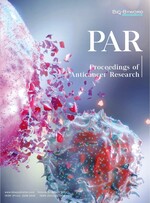Abstract
Objective: To explore the regulatory mechanism of ginsenoside Rh1 on breast cancer cell extravasation based on CCL20-CCR6. Methods: In 2021, a total of 34 patients with breast cancer were treated in Baoding First Central Hospital. During hospitalization, pathological examinations were performed, and all the patients were diagnosed with invasive ductal carcinoma. Out of the 34 cases, 16 cases were found to have CCR6 expression in breast cancer tissues, in which they were recorded as the CCR6 expression group, whereas 18 cases did not have CCR6 expression; these cases were recorded as the CCR6 non-expression group. During the same period, 21 normal patients were selected as the control group. The peripheral blood CCL20 level and the expression of CCR6 on the surface of CD3+ T lymphocytes were analyzed. The extracts of cancer cells were collected, purified, and cultured, and the effect of ginsenoside Rh1 on the invasion and metastasis of breast cancer cells was analyzed. Results: The peripheral blood CCL20 level in the CCR6 expression group was significantly higher than that in the CCR6 non-expression group and the control group, in which p < 0.05, indicating that the difference was statistically significant; at 12, 24, and 48 hours, the cell survival rate of each dose group was significantly higher than that of the blank control group and the dimethyl sulfoxide (DMSO) group (p < 0.05). At 48 hours, comparing the low-dose group with the high-dose group, the cell survival rate significantly decreased (p < 0.05). Compared with the blank control group and DMSO group, the invasion ability of breast cancer cells could be reduced in both, high- and medium-dose groups, where p < 0.05, indicating that the difference was statistically significant. Conclusion: CCL20 may play a role in the pathogenesis of certain breast cancers, and ginsenoside Rh1 can effectively regulate the invasion and migration of breast cancer cells.
References
Gao S, Xu P, Hao J, 2022, Research Progress of Macrophages in Tumor Development and Treatment. Chinese Journal of Cell Biology, 44(04): 572–582.
Jamiyan T, Kuroda H, Yamaguchi R, et al., 2022, CD68 and CD163 Positive Tumor-Associated Macrophages in Triple-Negative Breast Cancer. Journal of Clinical and Experimental Pathology, 38(03): 277.
Huang J, Yang Y, Sun Z, et al., 2022, Relationship between CD163-Marked M2 TAM and CD31-Marked MVD and Clinicopathological Features in Breast Cancer Microenvironment. Journal of Guizhou Medical University, 47(03): 279–285 + 307.
Yuan Y, Yu J, Wang Y, 2022, Effects of Exosomal miR-27a In Breast Cancer Cells on Macrophage Polarization and Tumor Growth and Metastasis. Journal of Clinical Surgery, 30(02): 149–154.
Mao X, Tong H, Dai H, et al., 2022, Endoplasmic Reticulum-Stressed Prostate Cancer Cells Promote M2 Polarization of Macrophages Through STAT3 Signaling Pathway. Medical Information, 35(03): 74–80 + 102.
Hai J, Zhang H, Yang H, et al., 2022, Correlation between MRIIVIM-DWI Parameters of Breast Cancer and MIP-1?, PDGF Expression and Its Clinical Diagnostic Value. Medical and Health Equipment, 43(01): 67–71.
Zheng W, Zhang S, Tang Y, et al., 2021, Study on the Mechanism of Ginsenoside Rh1 Regulating Breast Cancer Cell Extravasation Based on CCL20/CCR6. Chinese Pharmacology and Toxicity Journal of Science, 35(10): 756–757.
Shi Y, Yang S, Tang L, et al., 2022, Interaction between Tumor Stem Cells and Tumor-Associated Macrophages. Advances in Biochemistry and Biophysics, 49(06): 1075–1084.
Yuan S, Yang Y, Wang X, et al., 2021, Research Progress of CCL20-CCR6 Axis and Epithelial-Mesenchymal Transition in Breast Cancer. Journal of International Surgery, 48(06): 401–405.
Shen P, 2021, The Effect of Icariin on the Polarization Phenotype of Macrophages in the Tumor Microenvironment and Its Anti-Metastatic Effect on Breast Cancer, Shandong University, http://doi.org/10.27272/d.cnki.gshdu.2021.004438
Li Q, Ju L, Liu Z, et al., 2020, Application of High-Throughput Sequencing to Study the Effect of Ginsenoside Rh1 on Gene Expression of Breast Cancer SKBR3 Cells. China Journal of Traditional Chinese Medicine, 27(10): 48–53.
Li Q, Ju L, Wang N, et al., 2019, The Effect of Ginsenoside Rh1 on Gene Expression of Breast Cancer SKBR3 Cells Through KEGG Biological Pathway Enrichment Analysis. Chinese Medicine Herald, 25(20): 36–41.
Wang L, Quan N, 2019, Effects of Ginsenoside Rh2 on Apoptosis and MicroRNA Expression in Breast Cancer Drug-Resistant Cells MCF-7/ADM. Chinese Journal of Clinical Pharmacology, 35(16): 1794–1797.
Ju L, 2018, Effects of Ginsenoside Rh1 on Gene Expression of Breast Cancer SKBR3 Cells, Liaoning University of Traditional Chinese Medicine.
Zhang Y, 2018, Ginsenoside Rh1 Inhibits the Malignant Biological Behavior of HER2-Positive Breast Cancer Cells Through DDX5, Liaoning University of Traditional Chinese Medicine.
Qiu M, Qin S, Qin T, 2014, Expression and Significance of Cytokines and Related Receptors in Peripheral Blood of Breast Cancer Patients. Laboratory Medicine and Clinical, 11(23): 3310–3311.
